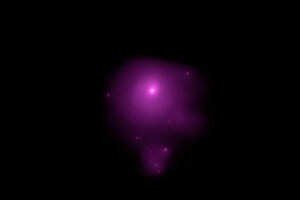New light on Dark energy in cosmos
A study shows it stifles galaxy growth as it helps expand the universe.

Stifled? Abell 85, located 740 million years from earth, was one of 86 galaxy clusters observed by NASA's Chandra X-ray Observatory to study dark energy's effects.
NASA/AP
A mysterious form of energy that is speeding the universe's expansion is now showing itself as a cosmic craftsman of sorts.
Astronomers have discovered that the repulsive force known as dark energy sets limits on how large clusters of galaxies can grow.
The new results, based on observations from NASA's Chandra X-Ray Telescope, provide a long-sought confirmation of dark energy's influence on the cosmos. That influence was first discovered serendipitously in the 1990s by astrophysicists studying the expansion rate of the universe. They found the universe's expansion rate was not slowing down as expected, but speeding up.
The new results show that in addition to accelerating the expansion of the universe, dark energy also affects individual structures within the universe.
It does this by allowing fewer galaxy clusters to form.
This "may well be called arrested development," says Alexey Vikhlinin, an astrophysicist at the Harvard-Smithsonian Center for Astrophysics in Cambridge, Mass., who led the research team.
"We're observing the unambiguous signature of the effects of dark energy on the growth of structure" in the universe.
Over the very long haul, the Chandra results imply that the universe will not end in a "big rip," with everything violently torn apart, as some astrophysicists had speculated. Instead, objects too loosely bound by gravity to overcome the repulsive force of dark energy will gradually vanish into the distance.
For instance, from the vantage point of the Milky Way, it will be lights out in a few tens of billion years for the Virgo Cluster, a gathering of at least 1,300 galaxies in a gravitationally corralled herd currently some 60 million light-years from Earth.
Confirming Einstein's theory
Scientists have puzzled over the origins of dark energy ever since it was discovered. The new results narrow the list of possibilities.
Two candidates remain standing, says David Spergel, a theorist in astrophysics at Princeton University in Princeton, N.J.
One involves an ultralight subatomic particle, dubbed quintessence, that is associated with the kind of force field that interacts very weakly with matter and is unstable. Some researchers suggest that this energy drove the rapid expansion the universe underwent in its inflationary period, calculated to have happened during the first trillionth of a second after the big bang. Energy from this quintessence field could be dark energy.
The other candidate is something called vacuum energy – a form of energy predicted by quantum physics. This energy would be present even if the universe had no matter. And it remains constant as the universe evolves, Dr. Spergel says.
In effect, it's Albert Einstein's cosmological constant – a fudge factor he included in his calculations of general relativity's effect on the universe. His calculations implied that gravity from all the universe's matter would force the cosmos to contract. But partial to a static universe, he factored in the constant to push things apart just enough to offset gravity's pull. He later called it his "greatest blunder" after observations showed that yes, the universe is expanding.
"A quantum fluctuation in a vacuum has some tiny energy associated with it," Spergel explains. And energy has mass. "One way to think about this is that even nothing weighs something. And because in our universe we've got a lot of nothing, it has a major effect on our evolution."
At this point, he says, the vacuum-energy approach describes dark energy well. In short: Einstein leads by a length.
Chandra's observations
Dr. Vikhlinin's international team used Chandra to observe some 86 galaxy clusters, typically ranging from 30 to 100 light-years across. The clusters are surrounded by enormous halos of hot gas that generate x-ray radiation. The halos represent the bulk of the cluster's matter. This allows astronomers to detect and study clusters at far greater distances than would be possible with visible light.
Roughly half the clusters were some 5.5 billion light-years away; the rest were virtually next door, at a distance of some 670 million light-years. The team also used data from the Wilkinson Microwave Anisotropy Probe, a satellite measuring in exquisite detail changes in the cosmic microwave background – the afterglow from the big bang 13.7 billion years ago – for clues about the universe's structure at the time.
The team used the two sets of clusters to track dark energy's effect at different periods in the universe's history. They found that dark energy was overcoming gravity as the universe's driving force when the universe was roughly half its current age.
The results square nicely with those from the 1990s studies based on supernovas that led to the discovery of dark matter. A special class of these exploding stars, which outshine their host galaxies, serve as standard candles for measuring distances, yielding clues as to how fast the universe is expanding at that distance.
Cluster growth "was fast up until 5.5 billion years ago, while it really slowed down afterwards," Vikhlinin says. "That coincides with the epoch in which the universe entered the accelerated-expansion phase revealed by the supernova data."
